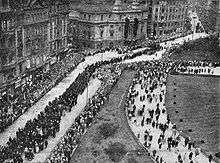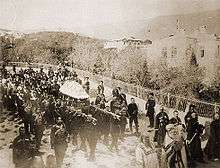Funeral procession


A funeral procession is a procession, usually in motor vehicles or by foot, from a funeral home or church or other place of worship to the cemetery or church. The deceased is usually transported in a hearse, while family and friends follow in their vehicles. In earlier times horse-drawn vehicles were used or in poorer societies a group of men would carry the deceased on a bier accompanied by a procession of people.
United States
The rules applied in most of the United States are:
- All vehicles traveling in a funeral procession must be accompanied by a licensed escort. Usually one escort is assigned for approximately every 10 to 12 vehicles.
- Funeral processions have the right of way. People are required to yield, and not interfere or cause an obstruction. Emergency vehicles and trains are excluded from this.
- Stickers (colored markers) must be attached to front and rear windows of each vehicle. Flags may also be used.
- Everyone that is part of the procession is required to have their lights turned on, and some states require the escort to use hazard lights.
Hinduism

A funeral procession in Hinduism normally takes place from the house of the deceased to the cremation ground and is normally an all-male affair.[1] The eldest son leads the procession followed by others.[2] Contrary to western traditions, the procession leaves as soon as possible after death and mourners chant the name of god en route to the crematorium.[3][4] The body itself is bathed and wrapped in a white sheet, carried to the cremation ground on a bamboo stretcher.[5] The son leading the procession carries a fire pot when he leaves the house, which is used to light the funeral pyre.[2][5]
See also
References
| Wikimedia Commons has media related to Funeral processions. |
- ↑ Smith, Bonnie G. (2008). The Oxford Encyclopedia of Women in World History, Volume 1. Oxford University Press. p. 14. ISBN 0195148908.
- 1 2 Michaels, Axel (2004). Hinduism: Past and Present. Princeton University Press. p. 133. ISBN 0691089531.
- ↑ Susai Anthony, Kenneth Schouler (2009). The Everything Hinduism Book: Learn the Traditions and Rituals of the "Religion of Peace". Everything Books. p. 251. ISBN 1598698621.
- ↑ Bowen, Paul (1998). Themes and Issues in Hinduism. Continuum International Publishing Group. p. 270. ISBN 0304338516.
- 1 2 "Gandhi's son will light traditional funeral pyre". Ocala Star-Banner. 24 May 1991. Retrieved 3 May 2012.